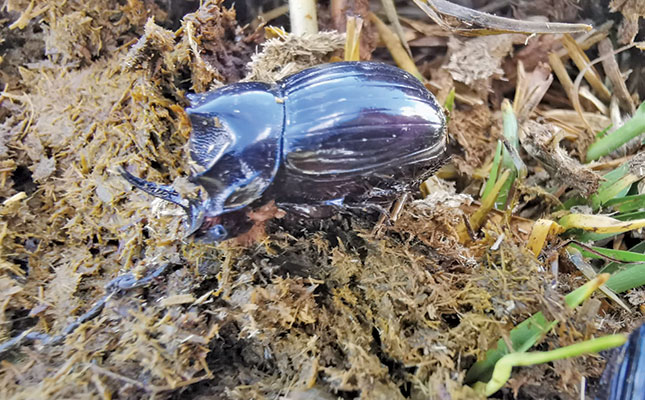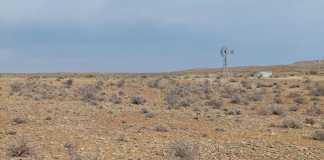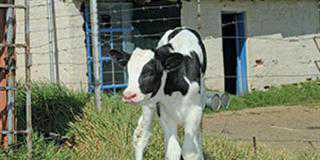
Photo: Dr Astrid Jankielsohn
Dung beetles perform a vital ecological function by clearing away the fresh droppings of large animals and recycling important nutrients such as phosphate and nitrogen, as well as carbon, back into the soil.
These actions help to increase the organic matter content of the soil, and aerate and mix the soil through burrowing. This improves nutrient availability and the soil’s water-holding capacity. Dung beetles also aid in the distribution of plant seeds contained in the dung and help keep pest and parasite populations under control.
The larvae of true dung beetles all feed on dung. Between 1965 and 1985, a total 1,7 million dung beetles of 55 species were imported into Australia from Hawaii, Africa and Southern Europe.
They were introduced to bury the dung of livestock, helping to eliminate the flies’ breeding medium. The introduction of dung beetles had a significant effect on Australian agriculture, land management, and the control of buffalo and bush flies.
Types of dung beetle
Dung beetles can be divided into three main groups: telocoprids (rollers), paracoprids (tunnelers) and endocoprids (dwellers). These groups are further divided into seven functional groups based on their size and method of manipulating dung.
“The diversity in this assemblage is important, as each group plays a role in the effective breakdown and distribution of the dung,” says Dr Astrid Jankielsohn, an entomologist at the Agricultural Research Council’s Small Grain Centre in Bethlehem in the Free State.
Rollers, which make up about 10% of dung beetle species, are perhaps the best known due to their habit of forming dung balls from manure and rolling them to a spot where they bury them in the soil.
They use their shovel-like heads as tools to cut the dung, and with the help of their spade-shaped forelegs, compact it into neat, round balls. The beetles roll the balls away from the dung pile by moving in reverse; their back legs push the balls and their front legs support them on the ground.
They form and use the dung balls for several reasons: as food storage, as nuptial
gifts and for brood balls. Two beetles can sometimes be seen rolling a dung ball until they find a suitable area where they will bury it.
The male and female mate underground, whereafter the female will lay an egg inside the ball.
To attract a female, a lone male places a small dung ball at the base of a short tunnel. He then retreats to the entrance where he releases a pheromone into the air to alert nearby female beetles that he has a ‘gift’. This is another way that he entices a female to mate with him.
Tunnellers dig into the manure and take little balls into tunnels that they dig underneath the manure patty.
Roller and tunneller dung beetles lay one egg in each manure ball they place in the soil. The egg hatches after several days and the larva eats its way around the interior of the ball, typically consuming 50% of it.
Finally, there are dwellers, which simply make their homes and lay their eggs in the manure patty.
Tunnellers and rollers improve the porosity of the soil and incorporate organic matter into it, increasing biological activity.
In South Africa, dung beetles are most active in the warmer and wetter months, with most spending the winter in hibernation.
They are typically active in hot, sunny weather after rain, and may live for up to three years.
Finding their way
During a recent online seminar on dung beetles hosted by the SANParks Honorary Rangers (the official volunteer organisation of SANParks), Prof Marcus Byrne, an entomologist and zoologist at the School of Animal Plant and Environmental Sciences at the University of the Witwatersrand, presented a talk on the celestial orientation of dung beetles.
Byrne is best known for discovering, with fellow scientists, that dung beetles can use the stars to navigate.
He is the co-author of the book The Dance with the Dung Beetle, and has been studying these insects for 30 years.
According to Byrne, dung beetles’ behaviour makes them model animals for studying orientation and navigation.
Dung beetles locate manure using smell. Once they find a suitable pile of dung, they sculpt a piece into a ball and start to roll it away along a straight path. According to Byrne, dung beetles use the position of the sun by day and the angle of the Milky Way by night to orientate themselves rapidly away from the dung pile, where competition is fierce and beetles try their best to steal each other’s dung balls.
The ancient Egyptians’ observations that the beetles’ ball rolling was influenced by the sun was actually accurate, and could be the first recorded accounts of animal behaviour.
“Ball-rolling diurnal dung beetles possess a dynamic celestial compass system in which the orientation precision and the relative influence of the solar compass cues change over the course of the day. We also found that in the compass system of dung beetles, the solar cues and the skylight cues are used together and share the control of orientation behaviour,” says Byrne.
In an experiment, researchers changed the sun’s position artificially by 180° by using a mirror. Byrne says that the majority of dung beetles, using the sun as the primary cue for straight-line orientation, compensated by changing their bearing as well.
In a recent study, Byrne also determined that dung beetles use wind to orientate themselves. On overcast days, or at midday when the sun is higher than 75° above the
horizon, the beetles cannot use the sun for orientation, as the directional information it provides is ambiguous.
Whichever way the beetle turns, the sun remains on the same side of its body. In these situations, it uses wind direction to orientate itself. Once the beetle has its bearings, it takes its dung ball and moves off in a straight line.
Dung beetle-friendly farming
According to Byrne, dung beetles are at risk due to habitat loss, habitat changes and, in particular, the impact of insecticide use. Dung beetles are seen as one of the major indicators of ecological and environmental health.
Unfortunately, some farming practices can actively damage beetles or disrupt their activity, but most of these practices can also be adapted to benefit the beetles. Practices that are harmful to dung beetles include treating of livestock with persistent antihelmintic drugs (used to kill parasitic worms or helminths). The residue of these drugs can persist in the dung and is lethal to the beetles.
It would seem that high-density grazing favours dung beetles, as it supplies many manure pats in a small area, which makes colonisation easy. But according to Jankielsohn, although high-density grazing would initially seem to have a positive effect on dung beetles, it may have the opposite effect.
The beetles’ activity can be disrupted by the large number of herbivores, and the beetles may not be able to secure their offspring’s future. If not managed properly, this practice can reduce dung beetle diversity.
Ideally, high-density grazing in small camps and ultra-high-density grazing on strips in camps should only be for short periods (three days at the very most). Rotational grazing and allowing fields or camps to remain fallow for at least three weeks between grazing periods will not only improve dung beetle activities, but help to break parasite cycles without the excessive use of chemicals.
Feedlots are not at all favourable, due to the constant high activity in the camps. According to Jankielsohn, dung beetles in particular play a crucial role in the recycling of dung, and the consequences would be dire if these insects were to disappear.
Farmers would be wise, she says, to reconsider some of their practices so that the populations of these insects are not adversely affected by farming activities.
If dung beetles were to disappear, the world as we know it would change, and not for the better, she warns.
So what can farmers do to increase dung beetle numbers and diversity?
- Select for genetic tolerance or resistance against external and internal parasites;
- Implement proper integrated pest management programmes and reduce the use of ‘hard’ chemical insecticides in favour of ‘softer’ products;
- Reduce the use of agro-chemicals, and treat only those animals that are actually infected with parasites, not the entire herd or flock;
- Focus on biological control of pests and diseases;
- Establish insect-protected areas on the farm;
- Move towards conservation and regenerative agricultural practices;
- Consider crop rotation; and
- Focus on diversity.
Email Prof Astrid Jankielsohn at [email protected].











